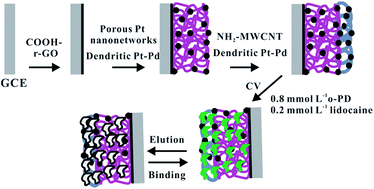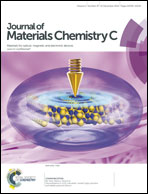A novel electrochemical sensor for the determination of lidocaine based on surface-imprinting on porous three-dimensional film†
Abstract
A novel molecularly imprinted electrochemical sensor was constructed for the determination of lidocaine, which has a porous and three-dimensional nanostructure. Firstly, dendritic Pt–Pd bimetallic nanoparticles (NPs) and porous Pt nano-networks (NWs) were prepared using hexadecylpyridinium chloride as a structure-directing agent. Then, the dendritic Pt–Pd NPs were embedded onto porous Pt NWs and the resultant mixture was coated on a carboxyl graphene modified glassy carbon electrode. Afterwards, the suspension of aminated multi-walled carbon nanotubes loaded with dendritic Pt–Pd NPs was dropped onto the modified electrode surface to reinforce such porous NW and enlarge electrode surface area. Subsequently, a molecularly imprinted polymer film was fabricated by cyclic voltammetry at the modified electrode, using lidocaine as the template and o-phenylenediamine as the monomer. Under optimal conditions, the obtained electrochemical sensor offered an excellent response for lidocaine, the linear response range was from 5.0 × 10−9 to 4.8 × 10−6 mol L−1 and the detection limit was 1.0 × 10−10 mol L−1. It was successfully applied to the detection of lidocaine in real samples with satisfactory results.


 Please wait while we load your content...
Please wait while we load your content...